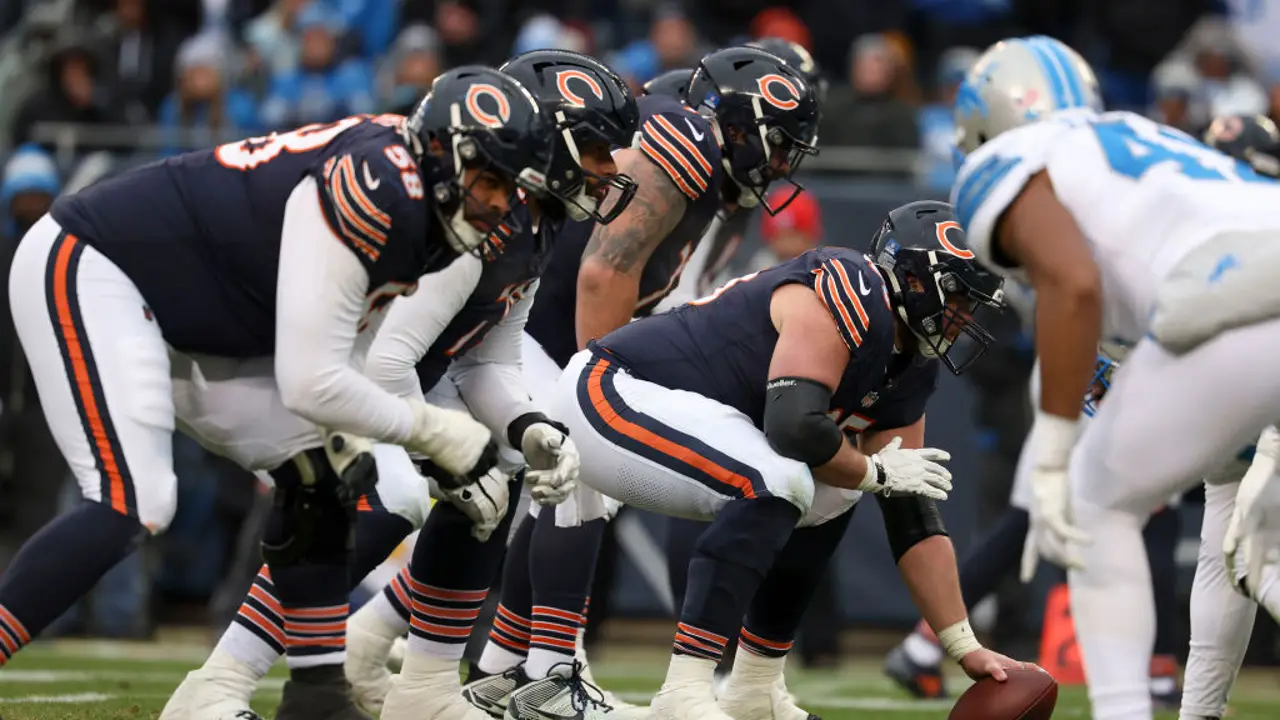The Different Ways How the Chicago Bears Can Rebuild Their Offensive Line
The Chicago Bears’ offensive line has long been a source of frustration for both fans and the coaching staff. While the team has made attempts in recent seasons to address the issue, it has remained one of their most glaring weaknesses. To support the development of young quarterback Justin Fields and to make their offense more competitive, the Bears must prioritize rebuilding the offensive line this offseason. There are several avenues through which the Bears can tackle this rebuild, each with its own set of advantages and challenges. Let’s take a look at the different ways the Bears can rebuild their offensive line and the benefits of each approach.
1. Free Agency: Signing Established Veterans
One of the most straightforward ways to rebuild the offensive line is to dive into the free-agent market. Free agency offers the opportunity to bring in proven, experienced players who can immediately contribute. The Bears would be able to fill multiple positions along the line with high-caliber talent without the risk and uncertainty that comes with drafting rookies.
Key Benefits:
- Immediate Impact: Free-agent signings can step in right away and help stabilize the offensive line, giving Justin Fields and the rest of the offense better protection.
- Veteran Leadership: Experienced linemen can provide leadership and help mentor younger players, which could have long-term benefits for the development of the entire offensive line unit.
- Flexibility: The Bears can target specific positions that need the most help, such as the left tackle or right guard spots, instead of relying solely on the draft.
Potential Drawbacks:
- Cost: High-quality free agents can come at a premium, and signing multiple veteran linemen can tie up significant cap space. The Bears would need to ensure they balance their spending wisely across their entire roster.
- Risk of Aging: While veteran players bring stability, they also come with the risk of declining performance, especially if they’ve played several years in the league.
Potential Free-Agent Targets:
- Orlando Brown Jr. (Tackle): A dominant force at left tackle, Brown could instantly upgrade the Bears’ offensive line.
- Ben Powers (Guard): A strong, experienced guard who would help immediately in pass protection and run blocking.
- Mike McGlinchey (Tackle): Known for his run-blocking abilities, McGlinchey could help improve both the passing and running game.
2. NFL Draft: Building for the Future
The draft is often considered the most sustainable and long-term solution for rebuilding an offensive line. By selecting high-potential young players, the Bears can build a line that will grow and gel over time, potentially forming a dominant unit for years to come. With several promising offensive linemen entering the 2025 draft class, the Bears are in a prime position to make a big splash early in the draft.
Key Benefits:
- Long-Term Investment: Drafting offensive linemen allows the Bears to lock down their line for several years, ensuring that they have young, healthy talent on the roster that can develop together.
- Cost-Effective: Rookies are significantly cheaper than free agents, allowing the Bears to allocate their resources to other areas of the team, like their defense or skill positions.
- High Upside: The right draft pick can provide immediate impact and become a cornerstone of the offensive line for many seasons.
Potential Drawbacks:
- Inexperience: Rookies can take time to adjust to the NFL and may struggle early in their careers. The Bears would have to be patient and willing to deal with some growing pains.
- Risk of Busts: Not all draft picks pan out, so the Bears would need to be diligent in scouting and selecting offensive line talent to avoid missing on key picks.
Top Draft Targets:
- Paris Johnson Jr. (Tackle, Ohio State): One of the best tackle prospects in the 2025 draft, Johnson could be a day-one starter at left tackle.
- Broderick Jones (Tackle, Georgia): A highly athletic and versatile player with great potential, Jones could play on either side of the line.
- O’Cyrus Torrence (Guard, Florida): Known for his immense strength, Torrence could immediately help the interior of the line.
3. Internal Development: Building From Within
Another option the Bears could pursue is focusing on the development of their current offensive line players. This involves sticking with the young talent they already have and giving them the coaching and resources to improve. Players like Teven Jenkins, Braxton Jones, and Cody Whitehair have all shown promise at times but need to show more consistency.
Key Benefits:
- Cheaper Option: The Bears would not have to spend large sums of money on free agents or trade for established players. Instead, they could invest in their current players’ growth and development.
- Familiarity: The team already knows the strengths and weaknesses of the players on their roster, so they can provide tailored coaching to help them succeed.
- Long-Term Development: Building from within gives younger players a chance to grow and potentially become long-term starters for the team.
Potential Drawbacks:
- Slow Progress: Player development takes time. While some players might make significant strides, others could remain inconsistent, which could result in another year of subpar performance on the line.
- Injury Risks: If the Bears rely on unproven or injury-prone players to start, they could face even more challenges if these players struggle to stay healthy or perform at a high level.
Focus Areas for Development:
- Teven Jenkins (Guard/Tackle): Jenkins has shown flashes of potential, but his growth has been hampered by injuries. The Bears will need to focus on getting the best out of him, either as a guard or tackle.
- Braxton Jones (Tackle): As a rookie, Jones showed some promise but also had growing pains. With proper coaching, he could develop into a reliable left tackle.
- Larry Borom (Tackle): Another young tackle, Borom will need to improve his consistency to become a reliable contributor on the line.
4. Trades: Adding Established Talent
The Bears could also consider making trades to bring in established offensive line talent. This approach could allow them to add a key piece without waiting for the draft or paying top dollar in free agency. A trade could be especially appealing if a team is looking to move on from a veteran player or if an experienced lineman becomes available at a reasonable price.
Key Benefits:
- Instant Help: A trade can bring in an experienced player who is ready to start immediately and make an impact.
- Filling a Specific Need: Through trade, the Bears can specifically target the position they need the most help at (e.g., left tackle or right guard).
Potential Drawbacks:
- High Trade Cost: Acquiring a top offensive lineman via trade may cost the Bears significant draft capital, which could limit their ability to improve other areas of the roster.
- Unknowns: A player acquired via trade may not fit into the Bears’ system or may struggle to adapt, leading to unforeseen challenges.
Potential Trade Targets:
- Laremy Tunsil (Tackle, Houston Texans): Tunsil is an elite left tackle, and while he may come at a hefty price, he could be the anchor the Bears desperately need.
- David Montgomery (Guard, Detroit Lions): While Montgomery is a guard and not a tackle, his experience could provide immediate help on the interior of the line.
- Garrett Bradbury (Center, Minnesota Vikings): If the Bears need a solid center, Bradbury could be available in a trade and would help stabilize the interior.
5. Position Switching: Experimenting With Current Players
Sometimes, position switches can offer a quick fix for a team with a shortage of offensive line talent. The Bears could experiment by moving players to different positions along the line to see if they can find a more effective combination. For example, Cody Whitehair could be moved from center to guard, or Teven Jenkins could shift between guard and tackle depending on where the team needs help.
Key Benefits:
- Cost-Efficient: No need to invest in new players, as this strategy only involves reworking the current roster.
- Maximizing Potential: Position switching could unlock new strengths in players, especially if they are better suited for a different spot on the line.
Potential Drawbacks:
- Risk of Disruption: Changing positions could lead to growing pains and disrupt the development of players who were already becoming comfortable in their current roles.
- Short-Term Solution: This strategy may not provide a long-term solution if the players struggle in their new positions.



